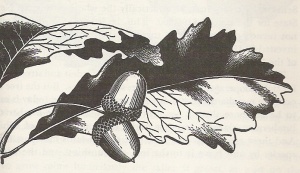 The Oaks are the most valuable hardwood in our area. The wood is durable, beautiful, and in demand both here and abroad for furniture, flooring, and veneer products. In the forest the acorn (called mast) is rated at the top of the wildlife food list because it provides nourishment during the crucial winter season.
The Oaks are the most valuable hardwood in our area. The wood is durable, beautiful, and in demand both here and abroad for furniture, flooring, and veneer products. In the forest the acorn (called mast) is rated at the top of the wildlife food list because it provides nourishment during the crucial winter season.
There are over 200 species of oak worldwide, several being local natives. The more common ones found in our area include: white oak, chestnut oak, post oak, northern red oak, black oak, southern red oak, scarlet oak, and chinkapin oak. Oak species are separated into two major groups: red and white. Generally the red oaks will have leaves with spiny, pointed edges, and have acorns that are bitter due to a high concentration of tannic acid. It requires two years for red oak acorns to germinate and begin to grow. The white oaks have leaves with rounded edges, and less bitter acorns that will germinate immediately under the right conditions. One way to tell a white oak acorn from a red is to look at the inside of the acorn cap. If the surface is fuzzy it’s a red oak, white is smooth.
Oaks are so cobenmmon in our area that our forest is given the broad category name “oak-hickory”. They are found from ridge tops to streams and rivers. Wildlife that use acorns as a major winter food source include deer, squirrel, turkey, grouse, blue jays, black bear, and chipmunk. Deer and rabbit also browse on the foliage and bark of young oak trees.
Both red and white oak species fetch a high price for their wood, and a young stand of oak trees is money in the bank if properly cared for. For information on how to properly manage oak and other valuable tree species contact the local Forestry office. Oaks are declining in our forest due to harvesting practices that allow other tree species to have a competitive edge. A forester can show you ways to encourage oak regeneration.
While not the fastest growing tree, oaks still make excellent shade trees and are a handsome addition to your home landscape. They are long lived and tolerant to many soil conditions, including compaction. Be sure to give them plenty of growing room, since they can reach 75 feet in height and have a crown spread of over 45 feet.

